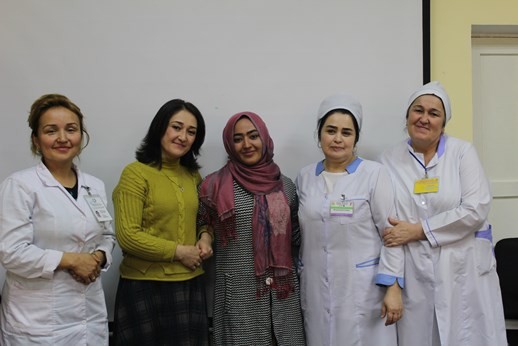Speeches Shim

May 2018—Gulbahor Mirzosharifova has had many firsts in her life, but the most important one happened recently when doctors told her she was the first patient in Tajikistan to be cured of multidrug-resistant tuberculosis (MDR-TB) using a new shorter treatment regimen recommended by the World Health Organization.
Mirzosharifova, who is 22 and lives with her family in Tajikistan’s capital city of Dushanbe, contracted MDR-TB from her brother. While her brother was treated using the standard 24-month treatment, Mirzoshirinova was treated with a new shorter regimen piloted by USAID. After just nine months of treatment, she was completely cured in October 2017, able to return to her normal life 15 months earlier than would have been previously possible.
MDR-TB is caused by bacteria that are resistant to the most common and effective TB drugs. It is more difficult to treat and requires extensive therapy with drugs that cause more side effects than standard treatment. With the old MDR-TB treatment regimen, patients receive injections for eight months and take 20-25 pills every day for two years. With the new regimen, patients receive drugs that are more effective, over a shorter period of time, which means patients are more likely to adhere to the regimen and complete the treatment course.
USAID’s Challenge TB project in Tajikistan has been working with Tajikistan’s National TB Control Program to introduce the shorter MDR-TB treatment regimen, creating necessary documentation and guidelines and training staff on how to care for patients and manage any side effects.
The shorter regimen lets patients return to their normal lives more quickly so they can resume their jobs and provide for their families. A shorter treatment regimen also saves money for the health care system.
Mirzosharifova was one of the first MDR-TB patients to receive the shorter treatment regimen in Tajikistan. “The treatment was very hard,” she remembers, “but it also changed my life. I have plans for the future now. I have decided to continue my education and apply to medical school. I want to help other people.”
As soon as she was cured, Mirzosharifova was able to return to her job in a local restaurant and is currently working on getting her high school diploma. Still, throughout her treatment, Mirzosharifova worried she would lose her job due to the stigma associated with TB. Although she was no longer infectious after the initial phase of treatment, widespread fear and misunderstanding about TB often make it difficult for people like Mirzosharifova to return to their lives.
Six additional patients in Tajikistan completed the shorter treatment regimen at the end of 2017. In 2018, Challenge TB will scale up access to the shorter treatment regimen in nine more districts, so more patients will have the chance to be cured in the shortest amount of time possible. The project runs from 2015 to 2020.
LINKS
Follow @USAIDCtrAsia, on Facebook, on Flickr, on YouTube

Comment
Make a general inquiry or suggest an improvement.